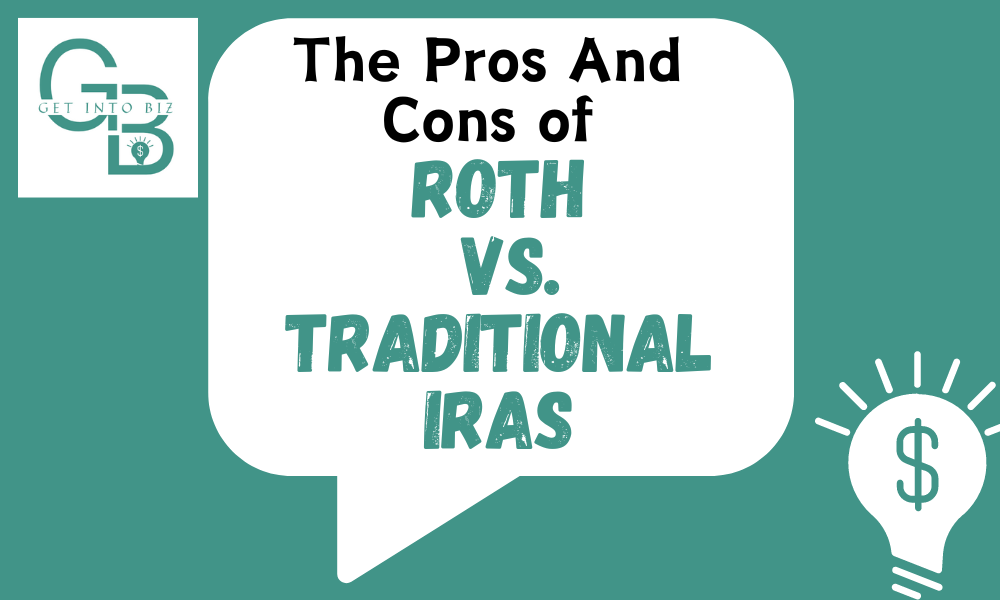Roth IRAs offer tax-free withdrawals, while Traditional IRAs provide tax-deductible contributions. Both have unique advantages and disadvantages that impact retirement planning decisions.
Choosing between Roth and Traditional IRAs depends on various factors, such as current income tax bracket, expected future tax bracket, and retirement goals. Roth IRAs are advantageous for those seeking tax-free growth and flexible withdrawal options, especially for younger individuals anticipating higher income in the future.
On the other hand, Traditional IRAs are beneficial for individuals in higher tax brackets currently who expect to be in a lower bracket during retirement years. Understanding the pros and cons of each type of IRA is crucial for making informed financial decisions.
Table of Contents
ToggleUnderstanding Roth And Traditional Iras
Key Differences
Roth IRAs and Traditional IRAs are both valuable retirement savings options, each with unique features and benefits. One key difference lies in the tax treatment of contributions and withdrawals. While contributions to a Traditional IRA are typically tax-deductible, withdrawals are subject to income tax. In contrast, Roth IRAs are funded with after-tax dollars, but qualified withdrawals are tax-free.
Tax Implications
The tax implications of Roth and Traditional IRAs differ significantly. With a Traditional IRA, contributions may be tax-deductible if certain requirements are met, providing potential immediate tax benefits. However, taxes are generally due upon withdrawal, based on income tax rates at the time. In contrast, Roth IRAs offer tax-free withdrawals of both contributions and earnings in retirement, potentially providing greater tax flexibility and advantages in the long term.
Pros Of Roth IRAs
Explore the benefits of Roth IRAs, offering tax-free withdrawals in retirement, flexible contribution options, and no required minimum distributions. Enjoy potential tax savings and greater financial flexibility for the future.
Tax-free Withdrawals
One of the major advantages of Roth IRAs is the ability to make tax-free withdrawals. With a traditional IRA, you contribute pre-tax dollars and pay taxes on your withdrawals in retirement. However, with a Roth IRA, you contribute after-tax dollars, so your withdrawals are completely tax-free. This can be incredibly beneficial in the long run, especially if tax rates increase in the future. The tax-free nature of Roth IRA withdrawals provides greater flexibility and peace of mind in retirement. Imagine being able to withdraw your money without having to worry about paying taxes on it. Whether you need the funds for healthcare expenses, travel, or simply to enjoy your retirement, the ability to make tax-free withdrawals can significantly enhance your financial situation.

No Required Minimum Distributions
Another advantage of Roth IRAs is that they do not require minimum distributions. Unlike traditional IRAs, which mandate that you start withdrawing funds at age 72, Roth IRAs do not have this requirement. This means that you can keep your money in your Roth IRA for as long as you want, allowing it to potentially grow and compound over time. The absence of required minimum distributions (RMDs) can be particularly advantageous for individuals who don’t necessarily need to tap into their retirement savings immediately. By leaving the money in your Roth IRA, it can continue to grow tax-free, giving you the option to pass it on to your inheritor or use it later in life when you might require additional financial support. Additionally, by avoiding RMDs, you can better control your tax liability in retirement. RMDs from traditional IRAs are typically subject to income tax, potentially pushing you into a higher tax bracket. With a Roth IRA, you have more control over your tax situation, as you can choose when and how much to withdraw from your account.
In conclusion, Roth IRAs offer significant advantages when compared to traditional IRAs. The ability to make tax-free withdrawals and the absence of required minimum distributions make Roth IRAs an attractive option for individuals looking to maximize their retirement savings. Consider the benefits and drawbacks of both types of IRAs before making a decision, and consult with a financial advisor to explore the best strategy for your individual circumstances.
Cons Of Roth IRAs
Roth IRAs have certain drawbacks that investors should be aware of before choosing this retirement savings option. Let’s explore the disadvantages associated with Roth IRAs in more detail:
Income Limits
Roth IRAs have income limits that determine who can contribute. If you are single, your income must be below $153,000 in 2024 to make a full contribution. For married couples filing jointly, the limit is $228,000. If your income is higher, you can only contribute a reduced amount or may not be able to contribute at all. These limits are based on your modified adjusted gross income (MAGI). It’s important to know these limits so you can plan your savings effectively and avoid any penalties. Check the current limits each year as they can change.
No Upfront Tax Deduction
When you contribute to a Roth IRA, you can’t deduct the contribution from your taxes that year. This is different from Traditional IRAs, where contributions can reduce your taxable income right away. With Roth IRAs, you pay taxes on the money before putting it into your account. The advantage is that your money grows tax-free, and you won’t pay taxes on withdrawals during retirement, as long as you follow the rules. This makes Roth IRAs a good choice if you think you’ll be in a higher tax bracket when you retire, offering long-term tax benefits despite no immediate deduction.

Pros Of Traditional Iras
Traditional IRAs offer upfront tax deductions and grow tax-deferred until withdrawal, making them an appealing option for those in higher tax brackets. They are a reliable choice for individuals seeking immediate tax benefits and willingness to defer taxes until retirement.
Traditional IRAs offer several advantages to those planning for retirement. Let’s take a closer look at some of the key benefits.
Upfront Tax Deduction
One significant advantage of a Traditional IRA is the potential for an upfront tax deduction. Contributions made to a Traditional IRA are typically tax-deductible, meaning you can lower your taxable income for that year.
This tax deduction can result in immediate tax savings, providing an opportunity to put more money into your retirement savings. By reducing your taxable income through this deduction, you can potentially pay fewer taxes in the current year.
Potential Lower Tax Bracket in Retirement
Another advantage of a Traditional IRA is the potential to be in a lower tax bracket during retirement. By contributing pre-tax dollars to a Traditional IRA, you can defer paying taxes until you withdraw the funds in retirement.
During retirement, if you expect your taxable income to be lower than during your working years, you can benefit from potential tax savings. This can be especially advantageous if you anticipate a lower income after retirement, as it may result in paying less tax on your withdrawals.
Overall, a Traditional IRA provides the opportunity for an upfront tax deduction and the potential to be in a lower tax bracket during retirement. These advantages can help you maximize your retirement savings and potentially reduce your tax burden.
Cons Of Traditional Iras
Considering the drawbacks of traditional IRAs is crucial to making an informed decision about retirement planning. While these accounts offer tax-deferred growth, they come with certain cons that may impact your financial strategy.
Required Minimum Distributions
Upon reaching age 72, traditional IRA holders must take Required Minimum Distributions (RMDs) from their accounts. If these distributions are not taken, the IRS can impose a substantial penalty of 50% of the amount not withdrawn. This inflexibility can disrupt your retirement income plans and potentially lead to unnecessary taxation.
Taxed Withdrawals In Retirement
One significant disadvantage of traditional IRAs is that all withdrawals, including contributions and earnings, are subject to income tax at the time of withdrawal. This taxation on distributions can reduce your retirement income and limit your purchasing power during your golden years.
Making An Informed Choice
Choosing between a Roth IRA and a traditional IRA is a crucial decision that could significantly impact your retirement savings. So, taking the time to make an informed choice is essential. By considering your current tax situation and evaluating your future retirement needs, you can consider the pros and cons of each type of IRA to determine the best option for your financial goals.
Considering Your Current Tax Situation
If you anticipate being in a higher tax bracket during retirement, a Roth IRA, where contributions are made with after-tax dollars, could be advantageous. On the other hand, if you expect to be in a lower tax bracket in retirement, a traditional IRA, offering tax-deductible contributions, may be more beneficial.
Evaluating Future Retirement Needs
When evaluating your future retirement needs, consider factors such as your age, projected income during retirement, and potential tax implications. A Roth IRA, with tax-free withdrawals in retirement, could be advantageous if you anticipate needing the funds and have a longer investment horizon. However, a traditional IRA, providing immediate tax benefits, could be beneficial if you anticipate lower income needs in retirement.
To sum up, both Roth and Traditional IRAs offer distinct advantages and disadvantages. Roth IRAs provide tax-free withdrawals in retirement, while Traditional IRAs offer immediate tax deductions. It ultimately depends on your current financial situation and future goals. Consider factors like tax rates, time horizons, and income levels to make an informed decision.
Consult a financial advisor for personalized advice. Take time to understand each option and choose the one that aligns with your long-term financial objectives.







